Propane’s role in the National Park Service
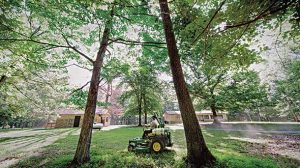
National Park Service locations seek to reduce greenhouse gas emissions by using propane. Photo courtesy of PERC
When Great Smoky Mountains National Park sought to invest in new alternative fuel vehicles for its fleet a few years ago, its management team spent no less than a few hundred hours researching propane autogas.
“I spent hundreds of hours on the phone looking into autogas,” says Brian Bergsma, deputy chief of facility management at Great Smoky Mountains National Park.
Bergsma also called a number of propane providers in the area, as well as representatives at Icom North America and Roush CleanTech to make sure autogas would be a good fit for the park’s fleet. The park integrated a Green Parks Plan in 2012 to help it reduce greenhouse gas emissions by using alternative fuel sources, and it connected with the Clean Cities coalitions in North Carolina and Tennessee to learn about alternative fuel vehicle options.
By the summer of 2016, the park resolved to add six bi-fuel Ford F-250 crew cabs to its fleet. It also installed two refueling stations for the vehicles and seven propane mowers at the park.
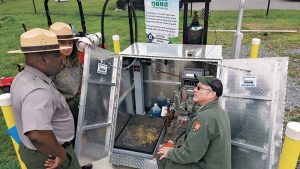
The Great Smoky Mountains National Park installed propane refueling infrastructure.. Photo courtesy of East Tennessee Clean Fuels
“The biggest factors that led us to propane were cost and availability,” Bergsma adds. “Many propane providers in the park were also happy to assist us with the fueling stations and information, and we received funding to purchase some of these vehicles. To date, we are experiencing anywhere between 30 to 70 cents per gallon savings.”
Other parks within the National Park Service have also aimed to reduce greenhouse gas emissions in recent years. In some of these cases, parks are turning to autogas and propane technologies as a solution to reduce emissions. For instance, Mammoth Cave National Park in Kentucky purchased four propane-powered buses and two propane pickup trucks to replace less-efficient vehicles a few years ago.
Although only a finite number of parks exist in the National Park Service, it features many propane-related pieces. The number of applications for propane within the parks could grow through conversations such as those that Bergsma had with retailers in his area. Those applications include opportunities to sell the parks on autogas, propane mowers, generators, fuel cells and more.
“This market is an opportunity that retailers can think about,” says Jesse Marcus, special programs manager at the Propane Education & Research Council (PERC). “Parks are off the grid and natural gas line. And many parks have used a little bit of propane, so it’s not totally new to them.”
Tried and true
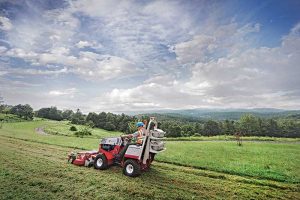
The Propane Education & Research Council donated propane-powered equipment, including three Ventrac compact tractor mowers, to Blue Ridge Parkway in Virginia. Photo courtesy of PERC
In recent years, the propane industry has been able to connect with National Park Service locations on a number of projects, thanks to the organization’s Green Parks Plan and partnerships with Clean Cities coalitions. PERC even helped to donate a fleet of propane Exmark Lazer Z S-Series lawn mowers to the National Mall and Memorial Parks in Washington, D.C., a few years ago.
Yet the relationship between the propane industry and the National Park Service spans almost two decades. Both Roy Willis, past president and CEO of PERC, and Larry Osgood, a consultant for PERC, pioneered PERC’s partnership with some of the national parks in the early 2000s to help develop the use of fuel cells that run on propane.
“We began our first research and development with the National Park Service as a result of their interest in fuel cells,” Osgood says. “PERC wanted to show that fuel cells could run on propane in the early 2000s. Once we validated that fuel cells could run on propane, the parks were a good place to locate some of the fuel cell tests.”
PERC also teamed with Glacier National Park in Montana in the early 2000s to encourage the park to convert its historic Red Bus tour buses to autogas. The park opted to place bi-fuel propane engines in 33 of its Red Bus vehicles and add a public propane fueling station, Osgood says.
Other parks, such as Acadia National Park in Maine and Zion National Park in Utah, followed Glacier National Park’s steps, transitioning their transport buses to run on propane, Osgood adds. Since then, some of those buses have reverted back to diesel or gasoline, but others have stuck.
“We were still learning about propane fuel systems in the early 2000s,” Osgood says. “The technology wasn’t always road-proven yet in terms of durability. It looked nice and worked nice, but did the technology really last the miles those buses needed? And it didn’t in some cases. So parts would have to be replaced over and over, and those replacements were expensive.”
However, Osgood notes that some of the bi-fuel buses from the early 2000s proved durable and are still in operation today, including a number at Acadia National Park and Zion National Park. With today’s improved autogas technology, he sees possibilities for the propane industry to continue to reach out to the parks.
“Today, we have much better propane fuel systems,” he says. “We are working to get new buses to replace these old ones or retrofit buses if they want to repair and rebuild them. Either way, we’re still making sure those buses are on propane.”
Working through obstacles
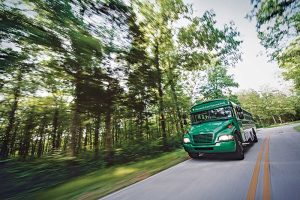
Some of the buses at Mammoth Cave National Park in Kentucky use propane autogas, according to the Propane Education & Research Council. Photo courtesy of PERC
Propane retailers have opportunities to reach out to National Park Service locations today, especially as more of them are looking to make their fleets more environmentally friendly. However, the market does pose some unique challenges.
“With a government agency like the National Park Service, sometimes decisions can’t be made quickly or locally,” Osgood says. “Sometimes they bid their fuel, and that’s not a preference for an area of the propane market that some propane marketers like to deal with.”
And while parks are interested in adding propane applications, many tend to be strapped for cash. This makes it difficult to purchase new vehicles without the help of grants.
“We have limited funding at the park unfortunately,” Bergsma notes. “As funds come available, we find avenues to buy more alternative fuel vehicles. I would love to see our fleet run 50 percent or more on autogas.”
Yet these challenges can be overcome through persistence and collaboration. When Blossman Gas and Sevier County Propane partnered with Great Smoky Mountains National Park to help install infrastructure for the park’s propane vehicles in North Carolina and Tennessee, respectively, both retailers learned that the parks have a number of restrictions on where propane tanks and infrastructure can be placed.
“By adding the autogas fueling system, we had to find a current propane tank location on-site that made sense in order to add it to the facility,” says Scott Prewitt, regional vice president at Blossman Gas. “There were restrictions on not being able to move certain tanks.”
Working with the parks requires a willingness to navigate codes and bylaws, Prewitt adds. Blossman Gas and Sevier County Propane each worked with the park in their respective states to find ideal locations for propane refueling infrastructures. In North Carolina, Blossman Gas and the park determined that a current tank at the park was out of code, so the park could move it and replace it with the refueling infrastructure.
“You need to help them jump through some of the hoops and help them find a solution that works best for them,” Prewitt says. “You have to be present and available for them when they need answers to questions or concerns. But your willingness to navigate them through the process helps.”
Abundance of applications
Propane can be used in many applications in the park. Here are some of those uses:
■ Alternative fuel vehicles: Service vehicles, pickup trucks, buses, maintenance vehicles, snow plows and utility cars
■ Fuel cells
■ Heating
■ Mowers
■ Power generation
Talking points
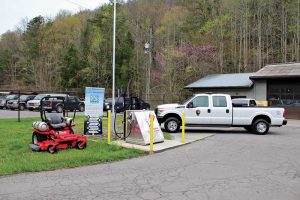
The Great Smoky Mountains National Park received new, propane-fueled equipment. Photo Courtesy of East Tennessee Clean Fuels Coalition
A few industry professionals offered the following advice on talking points and tips for when connecting with parks in the National Park Service.
“Express the benefits of propane technology. It’s clean burning, it’s cost efficient and it’s progressive. These things are important to note because propane often gets a stigma of being old-fashioned, and I don’t know why that is per se, but consumers need to know that propane is efficient and up to par with any other energy source out there.”
-Jesse Marcus
Special programs manager at the Propane Education & Research Council
“Do not promise what you can’t deliver to them and be patient. It takes time for parks to navigate the red tape. Be present and available for them when they need answers to their questions or concerns. Your willingness to help them navigate through the processes will help.”
-Scott Prewitt
Regional vice president at Blossman Gas
“Sometimes it’s a good idea to partner with a Clean Cities group. Many parks do participate in Clean Cities. And even if your local park doesn’t participate in your local Clean Cities but a park in a neighboring town does participate in it, encourage that park to talk to their local propane marketer about propane. Also, talk to someone in operations or the facilities maintenance supervisor at the park, and maybe send them an article on what another park has done with propane to share information.”
-Larry Osgood
Consultant for the Propane Education & Research Council
About the Green Parks Plan
The National Park Service initially developed the Green Parks Plan in 2012 to instill a vision and plan for sustainable operations across the parks. The parks are proactively informing park staff, visitors and community partners about its goals to influence climate change and sustainability.
Through this initiative, the parks have partnered with a number of Clean Cities coalitions. According to Clean Cities, the National Park Service has partnered with the coalitions on more than 30 projects to deploy alternative fuel vehicles and technologies at parks since 2010. A number of these projects include adding autogas vehicles to the parks. The following parks have partnered with Clean Cities coalitions to add propane autogas vehicles or propane mowers to their locations:
■ Blue Ridge Parkway in Virginia
■ Carl Sandburg Home National Historic Site in North Carolina
■ Catoctin Mountain Park in Maryland
■ Great Smoky Mountains National Park in North Carolina and Tennessee
■ Independence National Historic Park in Philadelphia
■ Mammoth Cave National Park in Kentucky
■ Mesa Verde National Park in Colorado
■ National Mall and Memorial Parks in Washington, D.C.
■ Nicodemus National Historic Site in Kansas
■ Pea Ridge National Military Park in Arkansas
■ Rocky Mountain National Park in Colorado
■ Saint-Gaudens National Historic Site in New Hampshire
■ San Antonio Missions National Historical Park in San Antonio
■ Shenandoah National Park in Virginia
■ Sleeping Bear Dunes National Lakeshore in Michigan
■ Wilson’s Creek National Battlefield in Missouri
View a list of all Clean Cities projects at National Park Service locations here.
















